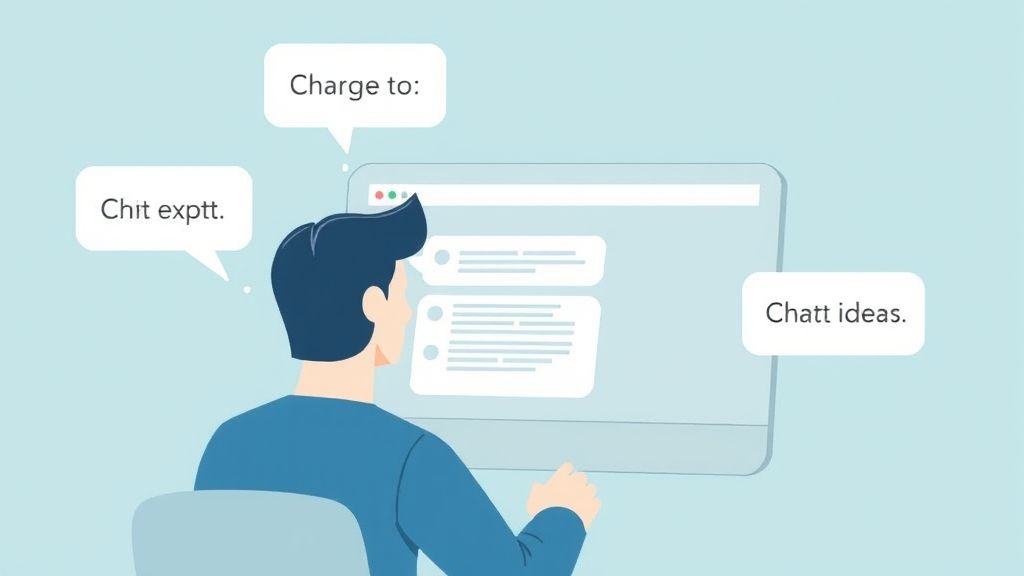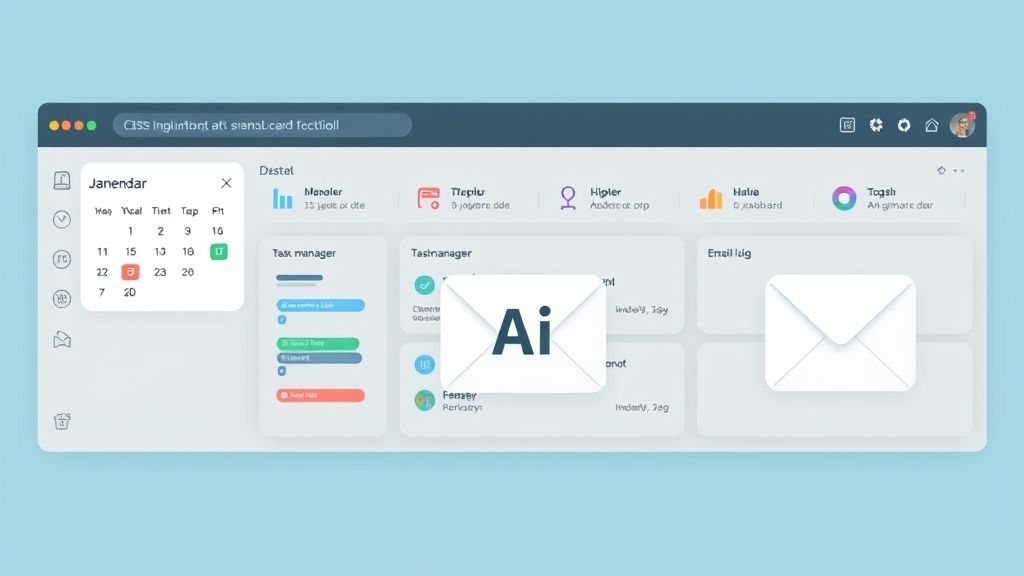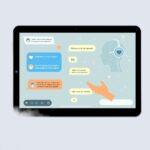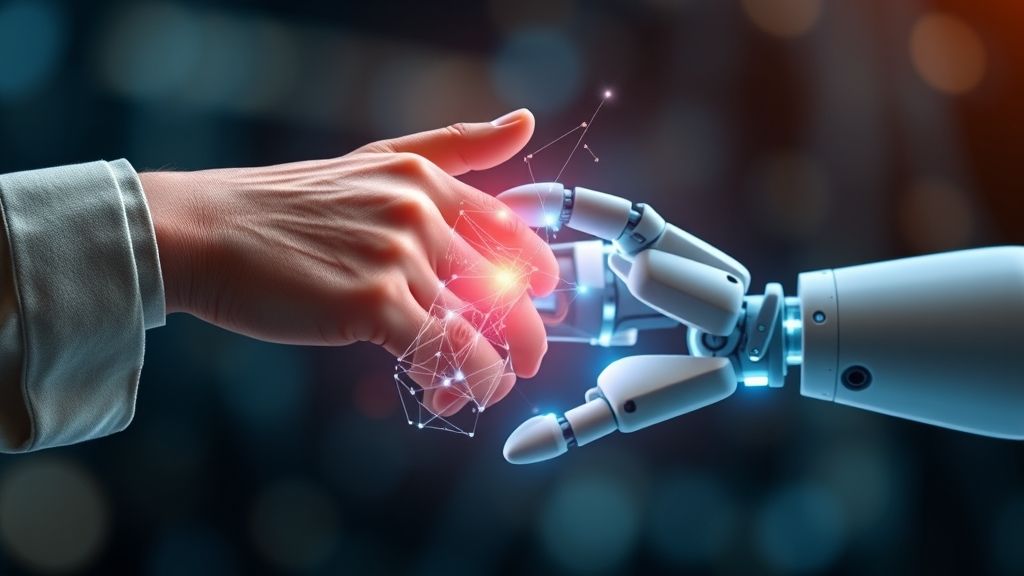The AI Revolution is Here (and It’s Actually Useful)
Ever stared at a blinking cursor for too long, struggling to write an email or blog post? Or maybe you’ve spent hours juggling calendar invites, meeting notes, and task lists—only to feel like you got nothing done. If that sounds familiar, you’re not alone.
But here’s the twist: those exact daily frustrations are now being handled—often better and faster—by practical AI tools.
While the world buzzed about artificial intelligence taking over jobs or building robot armies, something quieter (but far more useful) happened. AI started showing up in real, everyday tools—tools that help us write smarter, plan better, create faster, and even make sense of our overflowing inboxes.
And it’s not just for coders or tech geeks anymore. Whether you’re a content creator, small business owner, remote worker, or just someone trying to stay organized, there’s likely an AI tool out there already making your life easier—and if you’re not using it yet, you’re missing out.
What This Article Will Cover
In this guide, we’ll explore the rise of practical AI tools in 2025. We’ll break them down into three major categories:
- AI for productivity (Productivity) – AI that helps you get more done in less time.
- Creative AI tools (Creativity) – AI that boosts your ability to write, design, or brainstorm like a pro.
- AI for everyday life (Everyday Life) – AI that simplifies routines, automates chores, and enhances your personal workflow.
This isn’t about hype. It’s about useful, accessible AI tools that you can start using today to supercharge your day-to-day life.
Let’s dive in.
Table of Contents
Supercharging Productivity: AI as Your Intelligent Assistant
A. AI Writing Assistants: Unleash Your Inner Wordsmith (and Save Time)

AI for productivity – Whether you’re drafting blog posts, whipping up social media captions, or just replying to endless emails, writing well—and fast—has become an essential skill. But here’s the truth: not everyone is a natural wordsmith, and even the best writers have off days. That’s where AI writing assistants come in.
These tools aren’t just glorified spellcheckers. In 2025, AI writing platforms are powerful creative partners that can:
- Generate original content from a simple prompt
- Rewrite text to improve clarity or tone
- Summarize long documents in seconds
- Suggest compelling headlines or captions
- Brainstorm ideas and outlines for blog posts or videos
Some of the top tools right now include:
- ChatGPT (OpenAI): Great for long-form content, research, ideation, and even basic coding help.
- Jasper: Tailored for marketers and businesses, with templates for ads, landing pages, and product descriptions.
- GrammarlyGO: Combines editing with AI writing suggestions, perfect for polished emails and reports.
- Notion AI: Seamlessly integrated into Notion docs for instant summaries, bullet point conversion, and more.
Want to make the most of these tools? Here are some quick tips:
- Give clear prompts: The better your input, the better the output. Be specific about tone, length, and purpose.
- Edit with intention: AI can draft quickly, but your personal touch ensures clarity and credibility.
- Avoid overreliance: Let AI support you, not replace you. Use it to speed up the mundane so you can focus on high-value thinking.
A Glimpse Ahead
In the near future, expect AI writing assistants to become more conversational, context-aware, and voice-adaptable. Imagine a tool that understands your brand tone so well it writes exactly like you—consistently, across platforms.
B. AI-Powered Productivity Apps: Organize, Automate, and Conquer Your Day
We’ve all been there—drowning in to-do lists, forgetting calendar invites, juggling notes across apps. Productivity shouldn’t be this chaotic. Thankfully, in 2025, AI-powered apps are turning chaos into clarity.
These tools act like intelligent personal managers, helping you streamline workflows, automate repetitive tasks, and make better decisions with less mental strain.
Here’s how AI is changing the game:
✅ Smart Scheduling & Calendar Management
AI tools like Motion and Clockwise automatically prioritize tasks based on your energy levels and calendar availability. They rebook meetings intelligently and protect your deep work hours—no more triple-booking nightmares.
🧠 Intelligent Task Management
Platforms like Todoist with AI, ClickUp Brain, and Taskade now use machine learning to analyze how you work and suggest the most efficient way to tackle tasks. Think auto-prioritized to-do lists, deadline nudges, and smart grouping of related tasks.
📝 Note-Taking & Knowledge Capture
Tools like Notion AI, Mem.ai, and Obsidian with AI plugins can summarize meeting notes, extract action items, and even generate outlines from loose ideas. These aren’t just digital notebooks—they’re your second brain.
🔄 Workflow Automation
Apps like Zapier AI, Trello’s Butler, and Asana’s Smart Workflow Builder let you automate recurring tasks with natural language prompts. Schedule emails, move tasks between boards, assign priorities—all with a single click or prompt.
Real-World Example
A freelance designer might use Notion AI to outline client projects, Clockwise to optimize meetings, and Zapier AI to automate file storage. That’s hours saved every week—time that can now be spent actually designing.
Bottom Line
AI productivity tools in 2025 aren’t about working harder—they’re about working smarter. They help you reclaim time, reduce mental fatigue, and stay in control, no matter how busy life gets.
C. AI for Smarter Communication: Streamlining Emails and Meetings
If your inbox feels like a second full-time job and meetings leave you drained with barely any actionable takeaways—AI might just be your favorite coworker this year.
AI is revolutionizing the way we communicate in 2025 by minimizing the noise and maximizing the clarity. Whether it’s long-winded email chains or chaotic Zoom calls, smart tools are stepping in to help.
📧 Email Management Made Easy
Modern tools like Superhuman AI, Gmail with Duet AI, and Missive AI analyze the context of your inbox and draft intelligent replies instantly. You can ask the AI to “summarize this thread,” “write a polite decline,” or “respond urgently”—and it delivers.
Some platforms even categorize and prioritize messages automatically based on urgency, saving you from scanning through endless promotional clutter.
🧑💻 Meeting Summaries and Action Items
Tired of note-taking during meetings? Enter tools like Otter.ai, Fireflies.ai, Fathom, and Zoom’s AI Companion. These tools transcribe conversations, extract insights, and highlight action items in real time—perfect for both in-person and remote teams.
You can finish a meeting and instantly share a summary with your team, complete with timestamps and follow-ups.
🌍 Real-Time Translation & Accessibility
Communication is more global than ever. Tools like DeepL, Google Meet Live Captions, and Microsoft Teams AI offer real-time multilingual translation and automatic captioning—making conversations seamless and inclusive.
Use Case: Remote Startup Team
A globally distributed startup can rely on AI to draft internal updates, translate conversations between English and Japanese, and summarize weekly meetings—keeping everyone aligned without the time sink.
The Takeaway
Communication no longer needs to be time-consuming or lost in translation. With AI handling the logistics, you can focus on what truly matters—clarity, connection, and collaboration.
Unleashing Creativity: AI as Your Muse and Collaborator
Creative AI tools – In 2025, AI isn’t just about automating repetitive tasks or managing data—it’s also revolutionizing creative fields by offering a blend of assistance and inspiration. From music composition to visual art, AI is stepping into the role of a creative partner, helping both seasoned professionals and hobbyists to push the boundaries of imagination.

A. AI Tools for Content Creation: From Images to Music and Beyond
AI is transforming how we create, often providing a fresh perspective that challenges traditional methods. Here are some of the most exciting AI-powered tools currently shaping the world of content creation:
- Image Generation
Tools like DALL·E 3 and MidJourney have taken visual creativity to new heights by allowing users to generate high-quality, unique images from text prompts. Whether you’re creating artwork, marketing materials, or conceptual visuals, AI can generate visuals that align with your vision in just seconds. - Music Composition
For musicians and content creators, AI platforms like Brev.ai, Soundraw.io, and Amper Music are game-changers. These tools let you generate music tailored to specific moods, genres, or even video content. Whether you’re creating an anthem for a fitness video or background music for a product ad, AI offers a simple, customizable way to generate tracks without the steep learning curve of traditional music composition. - Video Editing and Design
AI-powered platforms like Runway ML and Magisto use machine learning to automatically edit video clips, add transitions, and even suggest edits based on the video’s content. These tools are especially useful for YouTubers, marketers, and content creators who need to churn out content quickly and consistently.
B. AI for Brainstorming and Idea Generation: Sparking Innovation
Creativity often thrives on collaboration—and AI is now the ultimate brainstorming partner. These AI tools act as thought catalysts, offering suggestions, analyzing trends, and proposing new angles for projects:
- AI Brainstorming Platforms
Tools like Copy.ai and ChatGPT are evolving into ideation hubs, where users can enter prompts and receive multiple variations of ideas, titles, or concepts. This takes the pressure off creatives struggling with the dreaded “blank page” syndrome, giving them a starting point to explore. - Trend Analysis and Market Insights
AI can help identify emerging trends and provide data-driven insights that inform your creative decisions. Platforms like TrendHunter and BuzzSumo use AI to analyze online content and predict what’s likely to gain traction. If you’re a marketer or content creator, this can help you align your projects with what’s hot right now—maximizing your potential reach. - AI-Powered Mind Mapping
Platforms like MindMeister now offer AI-enhanced brainstorming, which automatically links ideas and generates relevant concepts to explore, helping creators develop more robust, multifaceted projects. The AI serves as a guide through the creative process, allowing you to explore paths you may not have considered.
Ethical Considerations in Creative AI
While AI offers immense creative power, it’s crucial to be mindful of its ethical implications. One major concern is copyright—if an AI generates content, who owns the rights? The creative industry is still grappling with how to balance the ease and accessibility of AI tools with traditional copyright laws.
Moreover, while AI can inspire and assist, it doesn’t replace human creativity. AI-generated content can enhance creativity, but it’s still the human touch—the intent, emotion, and personal vision—that imbues the final product with meaning.
C. How AI Tools Help Overcome Creative Blocks
Every creative professional has faced a creative block at some point. AI-powered tools can offer much-needed relief by suggesting new ideas, giving prompts, or even generating a starting point for projects. Platforms like Brainstormer AI help by randomly combining concepts from different areas, making your brainstorming session less rigid and more exploratory.
The Takeaway: A Collaborative Future
The future of creativity is one of collaboration—human imagination paired with the analytical power of AI. These tools don’t just make the creative process faster or easier—they open new avenues for exploration, innovation, and efficiency. In 2025, AI is not just a tool but a creative ally, empowering you to unlock your full artistic potential.
Simplifying Everyday Life: AI for Personal Organization and Assistance
AI for everyday life – As AI continues to evolve, it is becoming an integral part of simplifying and organizing everyday life. Whether it’s keeping track of your calendar, managing your home, or assisting with personal health, AI tools are becoming essential in helping people stay organized and efficient in a fast-paced world. Here are some of the most innovative ways AI is enhancing our daily lives in 2025.
A. AI Personal Assistants: Beyond Voice Commands
Virtual assistants have come a long way. In 2025, they’re no longer limited to just setting reminders or answering questions. AI personal assistants like Siri, Google Assistant, and Amazon Alexa are becoming increasingly sophisticated, integrating with various apps and devices to offer proactive and intelligent support.
Proactive Reminders and Smart Scheduling
Unlike traditional reminders, modern AI assistants can anticipate your needs based on past behavior, location, and even your preferences. For instance, they can suggest the best time for meetings, automatically reschedule conflicting events, or remind you to take breaks based on your work patterns.

Intelligent Information Filtering
AI personal assistants can now help you filter through information. Instead of manually sifting through emails, news articles, or messages, your assistant can present summaries of only the most relevant content, saving you time and mental energy.

Integration with Smart Home Devices
AI assistants are seamlessly integrated with smart home systems. For example, you can adjust lighting, temperature, and security settings without lifting a finger. Some AI assistants can even predict your preferences based on past actions, making your home environment feel more tailored to your lifestyle.

Privacy Considerations:
As AI assistants become more integrated into our lives, privacy concerns arise. While the benefits of AI are clear, users should be mindful of the data these assistants collect. It’s crucial to understand how your information is being used and stored and to take steps to manage and secure your data.
B. AI for Smarter Home Management: Automation and Efficiency
AI is at the heart of the smart home revolution, making it easier than ever to optimize energy consumption, enhance security, and automate daily tasks.

Smart Energy Management
AI can analyze your energy usage patterns and make recommendations for reducing consumption. Smart thermostats, like Nest, learn your schedule and preferences, adjusting the temperature based on when you’re home or away, ultimately saving money on energy bills. Similarly, AI-driven lighting systems can adjust based on natural light levels, reducing electricity waste.

Enhanced Security
AI-powered security systems are making homes safer. Devices like Ring and Nest Cam utilize AI for facial recognition, detecting unusual activities, and sending alerts in real-time. This technology can significantly improve your home security, giving you peace of mind.

Automated Housework
AI-driven robots, like iRobot’s Roomba, are becoming more sophisticated in managing tasks like cleaning. These robots now feature advanced algorithms that map out your home’s layout, avoiding obstacles, and cleaning more efficiently. Smart appliances like AI-powered refrigerators can suggest grocery lists based on your usage patterns and even create meal plans.
C. AI for Health and Wellness: Personalized Insights and Support
AI’s potential in health and wellness is not just limited to fitness tracking. With a focus on personalized health management, AI tools can help users better understand their physical and mental health, as well as optimize their fitness routines.
AI-Powered Fitness Trackers
Devices like the Oura Ring and Fitbit now use AI to offer deeper insights into your daily activity levels, sleep patterns, and overall well-being. These trackers don’t just count steps—they analyze your health data and provide tailored recommendations for improving your physical fitness.

Personalized Health Monitoring
AI-driven health apps like Health Mate and Apple Health now offer insights into your personal health data, tracking everything from heart rate to calorie intake. They can identify patterns that may indicate potential health issues, such as elevated stress levels or irregular sleep, and suggest ways to improve your health proactively.

Mental Wellness Tools
Mental wellness is another area where AI is making a significant impact. Apps like Woebot use AI to engage users in therapeutic conversations, helping them manage stress, anxiety, and other mental health challenges. By providing personalized coping strategies and emotional support, AI can be a valuable tool for those seeking mental well-being in their busy lives.

The Takeaway: Streamlining Life with AI
As we move deeper into 2025, AI continues to refine its role in simplifying and enhancing our daily routines. Whether it’s organizing your day, optimizing your home, or taking care of your health, AI is becoming an indispensable tool for boosting productivity and improving quality of life. The future is one where AI anticipates our needs, manages tasks seamlessly, and gives us the mental bandwidth to focus on what truly matters.
The Future of Practical AI: What’s Next?
As we look toward the future, AI technology is poised to become even more integrated into our daily lives. While we’ve already seen its transformative impact in areas like productivity, creativity, and personal assistance, the next wave of AI advancements promises even more revolutionary possibilities. Here’s a look at what’s next for practical AI.
A. The Increasing Integration of AI into Everyday Software and Devices
AI is already a central component of many devices and applications, but its integration into everyday software is only going to increase. In the coming years, AI will be embedded in more software products that we use daily, making them smarter, more intuitive, and more personalized.
For instance, office productivity tools like Microsoft Word and Google Docs will continue to evolve with smarter AI features—offering real-time collaboration suggestions, more advanced grammar and tone adjustments, and even context-driven content creation. AI will also enhance video conferencing platforms, automatically adjusting settings like lighting and background, transcribing meetings, and even summarizing key points from discussions.
This increasing integration means that users won’t have to rely on standalone AI tools. Instead, they’ll experience AI as an invisible, seamless part of the applications and devices they already use.
B. AI-Enhanced Decision Making: From Personal Finance to Healthcare
In the coming years, AI’s role in decision-making is set to grow dramatically. We’re already seeing AI-driven platforms for personal finance, such as investment advisors and budgeting tools, but soon these tools will become even more advanced. AI could analyze your spending patterns, predict your financial future, and recommend adjustments to ensure long-term stability. This could extend to personalized investment strategies based on your financial goals and risk tolerance.
In healthcare, AI will continue to assist doctors and patients alike in making more accurate and timely decisions. AI’s ability to analyze vast amounts of data will allow for more precise diagnoses, personalized treatment plans, and even proactive health management. Imagine AI-powered systems that not only track your health metrics but can also anticipate potential issues before they arise, giving you the power to act before problems become severe.
C. Ethical Considerations and Challenges in Widespread AI Adoption
As AI becomes more integrated into our lives, it’s crucial to address the ethical implications of its widespread adoption. Concerns around privacy, data security, and bias in AI models will become more prominent, especially as these systems become deeply embedded in every aspect of our lives.
For example, AI personal assistants or healthcare applications collects vast amounts of personal data. The challenge will be to ensure that this data is stored securely and used responsibly. Moreover, there will be an increasing need for transparency in how AI makes decisions and how its biases are mitigated to ensure fairness and avoid discrimination.
D. Looking Toward a More Autonomous Future
The future of practical AI isn’t just about making our current tools smarter—it’s about creating a more autonomous world. Self-driving cars, smart cities, and autonomous robots are all on the horizon. AI-powered systems will be able to take over more complex tasks that currently require human intervention, from driving to home management to customer service.
In this more autonomous future, AI will be able to work in the background, allowing us to focus more on our personal passions, creative endeavors, and human interactions. While we may still need to provide oversight and make key decisions, AI will take on more of the repetitive or time-consuming tasks that bog us down, freeing up time and mental energy for more meaningful pursuits.
Final Thoughts:
The practical applications of AI in 2025 are already impressive, but what’s on the horizon is even more exciting. As AI continues to evolve, it will make our lives easier, more efficient, and more personalized. However, as we embrace these advancements, we must also stay mindful of the ethical considerations and challenges that come with widespread AI adoption. The future of AI is bright, but it will require thoughtful implementation and ongoing dialogue to ensure that its benefits are enjoyed by all.
Conclusion: Embracing the Intelligent Revolution

As we wrap up this exploration of practical AI tools, it’s clear that AI is no longer a distant, futuristic concept—it’s here, it’s practical, and it’s reshaping the way we work, create, and live. The tools we’ve discussed, from AI writing assistants and productivity apps to creative collaborators and AI personal assistants, represent just the tip of the iceberg. In 2025, we stand on the cusp of an AI-driven revolution that promises to impact every facet of our daily lives.
A. The Power of Practical AI
One of the key takeaways is that AI isn’t just for tech experts or large corporations. It’s accessible, affordable, and scalable, meaning anyone—from the busiest professional to the most casual tech user—can leverage these tools for increased efficiency, creativity, and overall life satisfaction. Whether it’s organizing your schedule, composing music, brainstorming your next big idea, or automating mundane tasks, AI can handle it all with remarkable precision and ease.
B. An Invitation to Explore
The future is an exciting place for those willing to embrace AI. As these tools evolve, the possibilities are limitless. We encourage you to experiment with the AI tools discussed here and discover which ones can truly make a difference in your productivity and creativity. Don’t just wait for the future—step into it. Try out an AI writing assistant to boost your writing, or a personal assistant to help manage your day. Explore creative AI platforms to collaborate on music, images, and videos. The more you experiment, the more you’ll see the power of these tools to enhance your daily life.
C. Looking Ahead: AI’s Potential to Shape Our Future
Looking forward, the integration of AI into software, devices, and even our decision-making processes will continue to grow. As AI becomes more intelligent, intuitive, and integrated, it will continue to simplify our lives, making the seemingly impossible possible. But as we embrace these technologies, it’s important to stay engaged in the conversations about ethics, data privacy, and AI’s evolving role in society.
Ultimately, AI’s most exciting promise is its potential to empower individuals to do more—whether that’s through increased productivity, creative breakthroughs, or smarter life management. As we continue to embrace and shape this intelligent revolution, it will undoubtedly transform how we interact with technology and the world around us.
Closing Thought:
AI is not just a tool—it’s a partner. It’s time to embrace the intelligent revolution and harness the power of AI to create a more productive, creative, and fulfilling future.
💡 Stay ahead of the future! Follow us on:
Facebook | LinkedIn


